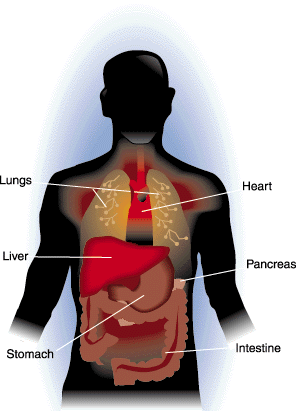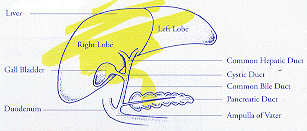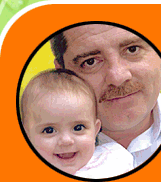A Guide to the Liver
Where is the liver?
The liver is located behind the lower ribs on the right side of the abdomen.

What does the liver look like?
The liver is reddish brown in colour. It has the consistency of foam rubber when healthy. In a child with liver disease it is often firmer. In an adult it is roughly the size of a rugby ball.
The liver has two main parts called the right and left lobes. There are over 300 billion specialised cells in the liver. These cells are served by a well organised intricate system of bile ducts and blood vessels.
The little bile ducts, which drain every liver cell, join together like tributaries entering a stream to form one main duct from each lobe. These two ducts join to form the common hepatic duct.

The common hepatic duct in turn joins with the duct from the gall bladder (called the cystic duct) to form the common bile duct. The common bile duct leads into the duodenum through the ampulla of vater in the first part of the small intestine.
The gall bladder is a pear-shaped organ which rests in a shallow furrow in the right lobe of the liver. The narrow end of the gall bladder, called the neck, opens into the cystic duct. Following a meal, the gall bladder collects the bile, concentrates it and passes it into the duodenum. This concentration process is not essential and digestion is rarely affected by removal of the gall bladder.
The blood supply to and from the liver
Blood enters the liver by two separate routes:
- The hepatic artery which brings freshly oxygenated blood to the liver. Within the liver the artery divides into fine branches which supply blood to the fine bile ducts. This blood passes on to special capillaries, called sinusoids, which take blood to every cell.
- The portal vein which carries blood containing nutrients from the stomach and intestine to the liver. The portal vein also carries blood from the spleen. This vein divides into very fine branches which drain into the sinusoids. The blood leaves the sinusoids by the hepatic vein and returns to the heart.
The spleen
The spleen, along with other tissues, plays a useful role in helping to fight infection. It destroys bacteria and old worn out blood cells. Removal of the spleen can make a child more susceptible to sudden severe infection.
How does the liver develop?
The liver is first seen in the developing embryo at four weeks of pregnancy. As the foetus develops, the liver divides into two, called the right and left lobes. The right lobe is six times bigger than the left. By the time the baby is born, the liver constitutes about 5% of the baby's body weight and grows with the baby. In the adult it weighs about 3lbs (1.5kg).
How important is the liver?
The liver is a vital organ. Without it we would not be able to live. Apart from the brain, it is the most complex organ in the body.
It has a wide range of functions and acts very much like a factory. One of its most amazing features is its regenerative power. Some 9/10ths of the liver can be cut away, and, provided the remaining 1/10th is healthy, the liver will grow back to its original size.
The liver is a processor
The food that we eat passes into the stomach via the oesophagus (gullet). [See diagram 1] The food is broken down by the action of the stomach and the small intestine.
The nutrients from the food are then absorbed into the blood via the vessels in the walls of the intestines. These drain to veins which lead into the portal vein which carries the blood into the liver. The nutrients are processed in many different ways in the liver. This processing of the food is known as metabolism. The final products made are used by the body for energy and growth.
The liver is a manufacturer
The liver produces a number of different substances which are vital in order for healthy growth and development. For example:
- The liver cells produce substances which assist with the clotting of the blood (e.g. Prothrombin).
- The liver cells make proteins which are carried in the blood. These have many functions. Albumin for example, helps to control the distribution of fluid in all the parts of the body and transports many substances to and from the liver and kidneys to other parts of the body.
The liver is a storage depot
The liver stores energy in the form of glycogen (sugar). It also stores a number of other substances (e.g. copper, iron and vitamins).
The liver is a controller
The liver plays an important part in controlling:
- The correct level of many hormones within the body.
- The blood sugar (glucose) levels. The liver stores glucose in the form of glycogen when there is too much glucose in the blood and releases it when the blood sugar level falls.
- The amount of fluid the body retains and its distribution throughout the body.
- The concentration of cholesterol which it converts into bile salts.
- The action of many drugs by chemically changing them.
The liver is a filter
The liver removes many unwanted substances from the body. It plays an important role in controlling the harmful effects of some drugs and products of metabolism by changing them chemically before excreting them into the bile.
Bilirubin (unconjugated or indirect) is produced when old red blood cells break down. The average life of a healthy red blood cell is 120 days.
This bilirubin is carried in the blood stream, attached to albumin, to the liver where it is altered into a different form (conjugated or direct bilirubin) which is then:
- excreted in the bile
- transferred into the bile which passes via the bile ducts into the intestine and appears as brown pigment in the stool.
Bile is continuously produced by the liver cells mainly by the action of bile salts. It collects in and passes out through the network of bile ducts into the intestine. Bile salts play an important role in the digestion of fats.
The liver is a defender
The liver plays an important role in fighting many types of infection. It particularly protects the body against infection which arises in the gut. With so many different and complex functions it is not surprising that more than 100 types of liver diseases have been identified in babies and children.
What kind of things can go wrong in babies and children?
If the liver cells are damaged, this causes inflammation, known as hepatitis. Depending on the cause, some or all of the functions of the liver may be disrupted to varying degrees.
There are five main causes of liver damage:
- An obstruction of the flow of bile out of the liver.
- An infection acquired before the baby was born, during delivery or caught at an early age after birth.
- Metabolic disease. If one of the many chemical processes occurring in the liver are faulty, liver damage may occur. The cause is usually genetic. This usually means that it is passed from both parents, each carrying the faulty gene to the child at conception, but usually perfectly well themselves.
- Certain drugs or poisons will damage the liver.
- Poor blood supply.
Sometimes it may not be possible to identify the cause of the hepatitis, despite extensive screening in a specialist unit. Idiopathic is a medical term meaning "no known cause." The number of idiopathic cases is decreasing as medical knowledge increases. But, too many cases are unexplained highlighting the need to continue research.
What are the signs and symptoms of liver disease?
- Jaundice (yellowing of the skin and the whites of the eyes)
- Nausea, vomiting and/or loss of appetite
- Yellow urine
- Grey or pale coloured stools
- Change of sleep patterns
- Vomiting of blood or the passing of blood in the stools
- Tiredness or loss of stamina
- Abdominal swelling caused by: a large liver or a large spleen or excess fluid in the abdomen (ascites)
- Itching
- Poor weight gain
- Abdominal pain
It is rare for all these signs and symptoms to be present in one child. Often only a few of the symptoms and signs will be noticed. Also the degree of severity will greatly vary depending upon the cause.
A previously undetected liver problem may be picked up during a routine medical check (e.g. six-week baby check or school medical), or when the child is examined by the doctor for another reason. The doctor may find a previously unsuspected large liver or spleen.
What treatment is available?
Some conditions require no treatment and will resolve themselves.
There are some treatments available; they include:
- Medicines
- Special diets
- Surgical operations
These treatments may not cure the condition but often control it, allowing the child to grow and develop.
If these treatments are not appropriate or fail to control the condition, then a liver transplant is now possible in many conditions.
Common questions>>

Return to top of page
back to top
   | 



